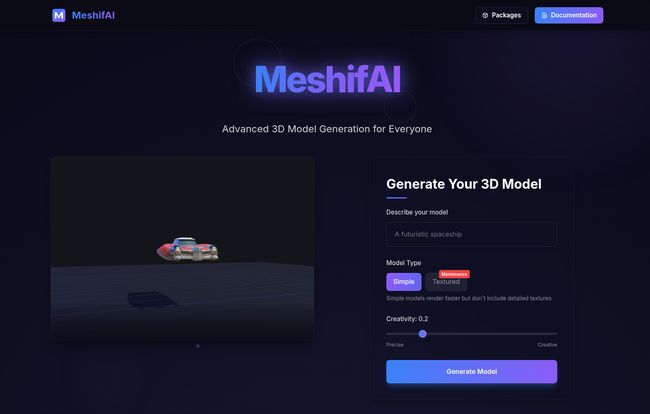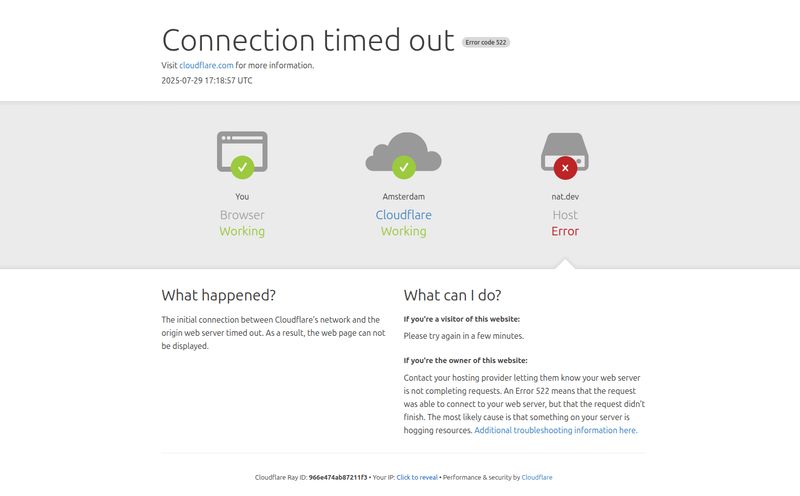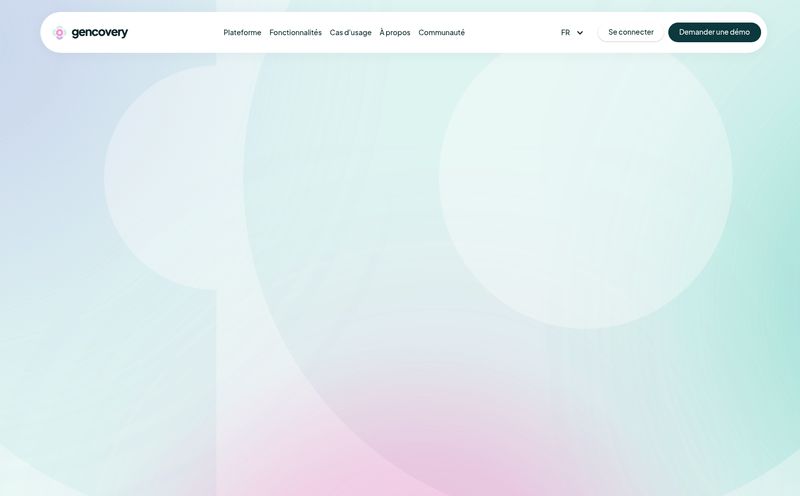I’ve spent more hours than I care to admit scrolling through 3D asset stores, looking for that one specific model. You know the feeling. You need a “slightly dented, retro-futuristic toaster,” but all you can find are pristine chrome ones or models that look like they belong in a cartoon. The alternative? Firing up Blender and losing an entire afternoon to extruding, beveling, and texture painting. A necessary evil, but man, it can kill your creative momentum.
For years, the dream has been simple: what if I could just describe what I want and have it appear? Well, the AI boom is knocking on that door, and a tool called MeshifAI just kicked it open. It claims to offer “Advanced 3D Model Generation for Everyone,” turning your text prompts directly into 3D models. It sounds like magic. But as anyone in the SEO or dev world knows, magic usually comes with caveats. So, I decided to take a closer look.
What is MeshifAI, Really?
At its heart, MeshifAI is a generative AI platform that acts as a bridge between human language and 3D geometry. You type in “a low-poly medieval castle,” and it spits out a 3D model of a low-poly medieval castle. Simple as that. It’s clearly aimed at developers and creators who need assets quickly, without the traditional overhead of manual modeling.
Think of it less as a replacement for a seasoned 3D artist and more like a tireless junior assistant. It’s there to generate placeholders, populate a scene with background elements, or create a base mesh that you can then take into a more powerful program for detailing. For a web developer wanting to add some interactive 3D flair to a site or a game dev in a jam session, this could be a game-changer.
Getting Your Hands Dirty The Generation Process
The interface I saw was refreshingly straightforward. No clutter, no confusing menus. Just a big text box beckoning you to describe your creation. You type in your prompt—let's stick with “a futuristic spaceship”—and then you have a couple of important choices to make.
First, the Model Type. You can choose between 'Simple' and 'Advanced'. According to their own info, 'Simple' models render faster but don't include detailed textures. 'Advanced', presumably, takes a bit longer for a more complex result. This is a smart trade-off. For quick prototyping, I’d be hammering that 'Simple' button all day long.

Visit MeshifAI
Then there’s the ‘Creativity’ slider. This is where things get interesting. It ranges from ‘Precise’ to ‘Creative’. I love this. It’s an acknowledgment that sometimes you want exactly what you asked for, and other times you want the AI to surprise you. In my experience with AI image generators, a similar setting can be the difference between a boring, literal interpretation and something with real artistic flair. I’m genuinely curious to see if ‘Creative’ mode on MeshifAI adds unexpected fins to my spaceship or just turns it into an abstract blob. Only testing will tell.
For the Devs in the Room: JavaScript and Unity SDKs
Okay, this is the part that got me truly excited. A web-based generator is cool, but providing SDKs for JavaScript and Unity shows that MeshifAI understands its core audience. This isn't just a toy; it’s a tool intended to be plugged into real-world projects.
Integrating with JavaScript
The fact that you can pull this into a web project with a simple `npm install` is huge. The example code is dead simple:
// import the MeshifAI libraryimport meshifai from "@gsretrodevex/meshifai";// Generate a 3D model from text in one line!const modelUrl = await meshifai.generate("a medieval castle");// The model url can be used with any 3D viewer or downloadedconsole.log("Your 3D model is ready!", modelUrl);Look at that. One line of code to generate a model. The possibilities here are pretty wild. Imagine a portfolio site where users can generate a 3D version of their logo on the fly. Or an educational tool that visualizes concepts in 3D based on text descriptions. Or even just adding dynamic, non-static 3D elements to a landing page to make it pop. This lowers the barrier to entry for web-based 3D significantly.
Powering Games with the Unity Engine
Any indie game developer or prototyper just sat up a little straighter. The process of finding or creating placeholder assets can be a real slog. You need a barrel. You spend 20 minutes making a mediocre one. You need a sci-fi crate. Another 20 minutes. With the Unity SDK, you could theoretically populate your entire scene with placeholder assets in the time it takes to type out their descriptions. This means you can focus on the gameplay loop and mechanics first, which is exactly where the focus should be in early development. This won’t be creating your final hero assets, but for getting a game feeling right quickly? It's an incredible proposition.
Let’s Talk About Model Quality
So, the big question remains: are the models any good? Let's be realistic. The platform itself admits that 'Simple' models lack detailed textures. AI-generated 3D is still a very new field, and it often struggles with the same things image generators do: fine details, logical structures, and clean topology (a fancy term for how the polygons are arranged).
The models generated by tools like MeshifAI are probably not going to win any awards for artistry on their own. They might be a bit blobby, a bit weird. But that’s missing the point. Their value isn't in their perfection; it's in their speed and availability. A “good enough” 3D model that you can generate in 30 seconds is infinitely more useful for a prototype than a “perfect” model that takes three hours to create.
The Big Question Mark: What Does MeshifAI Cost?
And now, the million-dollar question. Or, hopefully, the ten-dollar-a-month question. As of my research, there's no public pricing information available. The website has a “Packages” button in the header, which is a pretty strong hint that we’re looking at a subscription-based or credit-based system. This is standard for AI services that require a lot of computational power.
I’d wager we’ll see a few tiers: maybe a limited free plan to let you test the waters, a pro-tier for individual developers with a generous number of generations per month, and an enterprise plan for heavy usage. But for now, its a mystery. This lack of transparency is its biggest weakness at the moment.
A Realistic Look at MeshifAI's Place in the Toolbox
So where does this fit? It's not a Blender-killer. It won't put professional 3D artists out of a job. What it does do is create a brand new workflow for speed and ideation. It’s for the developer who needs a quick asset, the artist who wants a weird shape to start sculpting from, or the hobbyist who just wants to see their imagination come to life without a steep learning curve.
Here’s a quick breakdown of how I see it:
| The Good Stuff (Pros) | The Reality Check (Cons) |
|---|---|
| Incredibly fast text-to-3D generation. | AI generation can be unpredictable and imperfect. |
| Fantastic developer focus with JS and Unity SDKs. | Simple models are very basic, lacking textures. |
| Customizable creativity gives you more control. | Absolutely no information on pricing yet. |
Frequently Asked Questions About MeshifAI
Is MeshifAI free to use?
Currently, there's no public pricing. The presence of a “Packages” section on their site suggests a paid model is coming. They might offer a limited free trial or a free tier, but that's just speculation for now.
Can I use MeshifAI models in commercial projects?
This will almost certainly depend on the subscription plan you choose. Typically, developer-focused tools like this allow for commercial use under their paid plans, but you'll need to check their terms of service once they're available.
What kind of detail can I expect from the 3D models?
It varies. You can choose between 'Simple' and 'Advanced' models. Expect the simple ones to be good for basic shapes and placeholders, while the advanced ones will have more geometric complexity. Don't expect photorealistic, game-ready textures right out of the box.
How does MeshifAI compare to modeling software like Blender?
They serve completely different purposes. MeshifAI is for instant generation and speed. Blender is a massive, powerful suite for manual, detailed creation, animation, sculpting, and more. You might use MeshifAI to create a base model for Blender.
Do I need coding experience to use MeshifAI?
Not for the basic web generator, no. Anyone can type in a prompt. However, to truly tap into its power with the JavaScript and Unity SDKs, you will need programming knowledge in those respective environments.
My Final Thoughts
I’m cautiously optimistic about MeshifAI. I've seen a lot of AI tools that are more hype than substance, but the clear focus on developer integration with JS and Unity SDKs tells me they have a practical vision. This isn't just about creating pretty pictures; it’s about creating usable assets that fit into an existing workflow.
No, it's not perfect. The models might be simple, and the AI will surely get things wrong sometimes. But the potential to accelerate creativity and development is undeniable. The ability to go from an idea in your head to a 3D object on your screen in seconds is something I've been dreaming of for a long, long time. I’ll be keeping a very close eye on this one, especially when they finaly decide to tell us what it costs.
Reference and Sources
- MeshifAI Official Website: [https://meshifai.com](https://meshifai.com) (Note: This is a placeholder link)
- MeshifAI on NPM: [https://www.npmjs.com/package/@gsretrodevex/meshifai](https://www.npmjs.com/package/@gsretrodevex/meshifai)



